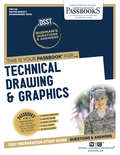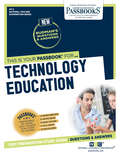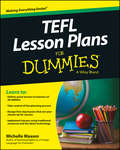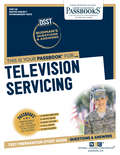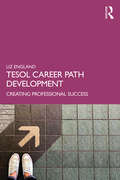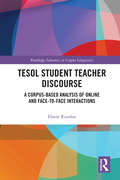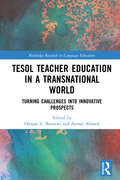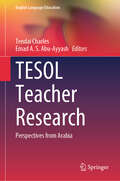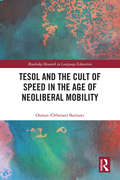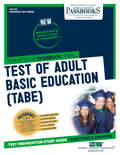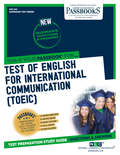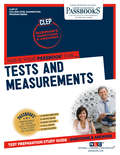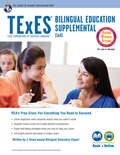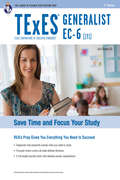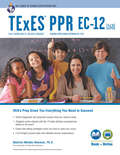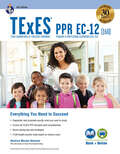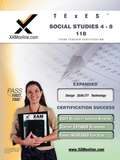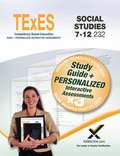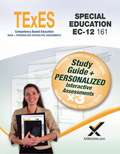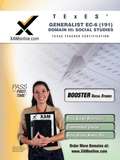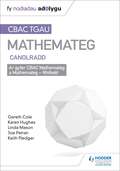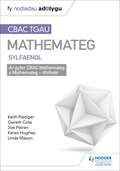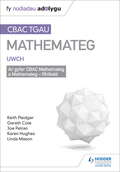- Table View
- List View
TECHNICAL DRAWING & GRAPHICS: Passbooks Study Guide (DANTES Subject Standardized Tests (DSST))
by National Learning CorporationThe DSST Subject Standardized Tests are comprehensive college and graduate level examinations given by the Armed Forces, colleges and graduate schools. These exams enable students to earn college credit for what they have learned through self-study, on the job, or by other non-traditional means. The DSST Technical Drawing & Graphics Passbook® prepares candidates for the DSST exam, which enables schools to award credit for knowledge acquired outside the normal classroom environment. It provides a series of informational texts as well as hundreds of questions and answers in the areas that will likely be covered on your upcoming exam.
TECHNOLOGY EDUCATION: Passbooks Study Guide (National Teacher Examination Series (NTE))
by National Learning CorporationThe National Teacher/PRAXIS Examinations are designed to provide objective measurement of the knowledge, skills and abilities required of teachers. The Passbook® for the Technology Education exam provides hundreds of multiple-choice questions in the areas that will likely be covered on your upcoming certification test.
TEFL Lesson Plans For Dummies
by Michelle M. MaxomInstant English lessons – learn in a flash! TEFL Lesson Plans For Dummies is a ready-made course manual for TEFL teachers. With fully fleshed-out lessons, activities, tools, games, and resources, this book contains what is essentially an instant TEFL course. Use the ready-made materials directly in the classroom, or follow along with the detailed planning models and frameworks to grow your skills while designing your own lesson plans more effectively. The book includes access to online materials you can print for use in class, and the lessons can be used with or without the aid of technology in the classroom. You'll find expert advice on teaching all age levels and class sizes, including ideas for taking the lessons out into the world. Many EFL/ESL teachers have little or no experience, and may have only been in the profession for a limited time. TEFL Lesson Plans For Dummies saves the day with materials, ideas, and activities that can be implemented quickly and easily, making lessons more productive and fun. From quick exercises to larger-scale plans, this book contains hundreds of ways to help your students become more proficient English speakers. Implement expertly-designed planning models with step-by-step advice Teach lessons designed for students of all ages and classes of all sizes Integrate technology when it's available, or do without it when it's not Move your lessons outside of the classroom for deeper immersion Whether you're taking a TEFL training course, about to head out on your first job, or a veteran of the field, this book provides you with the tools you will need to get things moving in class. If you're looking to cut down on planning time without sacrificing student engagement, TEFL Lesson Plans For Dummies is the classroom-ready resource you need.
TELEVISION SERVICING: Passbooks Study Guide (DANTES Subject Standardized Tests (DSST))
by National Learning CorporationThe DSST Subject Standardized Tests are comprehensive college and graduate level examinations given by the Armed Forces, colleges and graduate schools. These exams enable students to earn college credit for what they have learned through self-study, on the job, or by other non-traditional means. The DSST Television Servicing Passbook® prepares candidates for the DSST exam, which enables schools to award credit for knowledge acquired outside the normal classroom environment. It provides a series of informational texts as well as hundreds of questions and answers in the areas that will likely be covered on your upcoming exam.
TESOL Career Path Development: Creating Professional Success
by Liz EnglandThis book addresses a wide range of issues and obstacles that teachers in native and non-native English-speaking countries face in teaching English language learners of all ages, at all levels of proficiency, and in a variety of program settings. The book introduces a model of milestones for career path development specific to the specialized needs and skills of the TESOL (Teaching English to Speakers of Other Languages) community that caters to the many unique challenges faced by teachers at a range of experience levels, from preservice and novice teachers to veteran and semi-retired professionals. Taking an interdisciplinary approach and drawing on the voices and experiences of TESOL scholars, England demonstrates how best to apply one’s education, background, and experiences to individuals who work in the field of TESOL, and offers unique tools, strategies, and training techniques. This book provides a clear and engaging framework for scholars and teachers at any stage in one’s career to grow and develop professionally in fast-changing and increasingly complex professional climates. This book is ideal for scholars, graduate students, and researchers in TESOL and language teaching, as well as scholars and researchers in international teacher development and language.
TESOL Student Teacher Discourse: A Corpus-Based Analysis of Online and Face-to-Face Interactions (Routledge Advances in Corpus Linguistics)
by Elaine RiordanThis book explores the use of online and face-to-face interactions in language teacher education (LTE) by assessing the formation and practices of a community of practice (CoP), and evaluating the roles discussions between student teachers and a peer tutor can play in terms of identity formation, articulating narratives, reflective practices, and maintaining affective relationships. The specific context within which this is embedded is a Teaching English to Speakers of Other Languages (TESOL) programme, often known as English Language Teaching (ELT), at a third-level Irish institution. The data drawn on come from student teachers on a master’s (MA) programme who interacted with a peer tutor (the researcher) via a number of modes (face-to-face and online). The approach to data analysis is a corpus-based discourse analytical one, which examines the linguistic features of student teacher and peer tutor talk; the features of CoP practices in the discourse; and how different modes of communication shape the nature of this discourse. Perceptive data from the student teachers is used to outline their reactions to the modes of communication and the activities they participated in.
TESOL Teacher Education in a Transnational World: Turning Challenges into Innovative Prospects (Routledge Research in Language Education)
by Osman Z. Barnawi and Anwar AhmedTESOL Teacher Education in a Transnational World critically examines theories and practices in contemporary TESOL teacher education to shed new light on the intersection of transnationalism and language teacher education. It emphasizes the scholarship of transnational mobility of language teachers, and showcases critical research from diverse contexts. The book fills a critical research gap by more fully examining the theory and practice of teacher education in a changing time when national identities and cross-border mobilities continue to figure prominently in scholarly discussions. Through a diverse set of epistemological, historical and theoretical perspectives along with methodological innovations, contributors of this volume not only index the dynamism of the scholarship of teacher education, but they also offer new forums for lively pedagogical debates. Featuring contributions from diverse educational and geographical contexts, including Europe, Asia, North America, and Latin America, the book moves the existing scholarship forward to more fully examine TESOL teacher education in relation to transnationalism. This book will be of great interest to academics, scholars, post-graduate students, teacher educators, policymakers, curriculum specialists, administrators, and other stakeholders interested in language teacher education, TESOL and applied linguistics
TESOL Teacher Research: Perspectives from Arabia (English Language Education #35)
by Tendai Charles Emad A. S. Abu-AyyashThis edited volume provides a comprehensive and detailed insight into the Teaching of English as a Second Language (TESOL) in the United Arab Emirates (UAE). It describes a variety of challenges that native speakers of Arabic face when learning the English language and presents contemporary teaching strategies for supporting them. The book provides analyses of TESOL syllabi and policies currently adopted in the UAE’s K-12 education sector, addressing strengths and areas which can be improved. The book also includes a critical discussion about the difficulties of implementing Western-based TESOL methodologies in a Middle Eastern context, from the perspectives of real-world practitioners. By presenting a combination of research-based and theory-based chapters, this book is a great resource to TESOL-related graduate students, teachers-in-training, educational leaders and policy makers in the UAE and beyond.
TESOL and the Cult of Speed in the Age of Neoliberal Mobility (Routledge Research in Language Education)
by Osman Z. BarnawiTESOL and the Cult of Speed in the Age of Neoliberal Mobility argues that because the nexus between TESOL and the cult of speed in an age of increased neoliberal mobility has not yet been explicitly unpacked, discussed, identified and theorized, the implications of this socio-economic phenomenon for TESOL policies, curricula, pedagogies and practices have been overlooked. Through the presentation of several qualitative case studies, the book illustrates the social dynamics of speed and its key aspects (i.e., the materiality and the politics of time) in different TESOL contexts, including Saudi Arabia, the USA and Canada. The aim in presenting these diverse case studies was to craft a collection of responses, which, when put together, could offer new insights into the TESOL academic community. The book examines the ways in which the cult of speed has been envisioned, celebrated, negotiated with, enacted and justified by the various actors within the contemporary field of TESOL. It also investigates the new language teaching practices and forms the cult of speed in TESOL has generated and is generating. TESOL and the Cult of Speed in the Age of Neoliberal Mobility will be of interest to TESOL/applied linguistics educators, students, policy makers, administrators, employers and the wider community, and it is hoped will give them ideas about how to deal with today’s culture of fast movement in the globalized higher education landscape.
TEST OF ADULT BASIC EDUCATION: Passbooks Study Guide (Admission Test Series)
by National Learning CorporationThe Admission Test Series prepares students for entrance examinations into college, graduate and professional school as well as candidates for professional certification and licensure. The Test of Adult Basic Education (TABE) Passbook® prepares you by sharpening the skills and abilities necessary to succeed on your upcoming entrance exam. It provides hundreds of questions and answers in the areas that will likely be covered on your upcoming exam.
TEST OF ENGLISH FOR INTERNATIONAL COMMUNICATION: Passbooks Study Guide (Admission Test Series)
by National Learning CorporationThe Admission Test Series prepares students for entrance examinations into college, graduate and professional school as well as candidates for professional certification and licensure. The Test of English for International Communication (TOEIC) Passbook® prepares you by sharpening the skills and abilities necessary to succeed on your upcoming entrance exam. It provides hundreds of questions and answers in the areas that will likely be covered on your upcoming exam.
TESTS AND MEASUREMENTS: Passbooks Study Guide (College Level Examination Program Series (CLEP) #Clep-27)
by National Learning CorporationThe College Level Examination Program (CLEP) enables students to demonstrate college-level achievement and earn college credit in various subject areas based on knowledge acquired through self-study, high school and adult courses, or through professional means. The CLEP Tests and Measurements Passbook® prepares you by sharpening knowledge of the skills and concepts necessary to succeed on the upcoming exam and the college courses that follow. It provides a series of informational texts as well as hundreds of questions and answers in the areas that will likely be covered on your upcoming exam.
TExES Bilingual Education Supplemental (TExES Teacher Certification Test Prep)
by Dr Luis A. RosadoREA's TExES Bilingual Education Supplemental (164) Test Prep with Online Practice Tests Gets You Certified and in the Classroom!Teacher candidates seeking certification to become bilingual teachers in Texas public schools must take the TExES Bilingual Education Supplemental (164) test.Written by Dr. Luis A. Rosado, director of the Center for Bilingual and ESL Education at the University of Texas at Arlington, this REA test guide provides extensive coverage of the exam’s four competencies. Dr. Rosado was named a 2018 International Latino Book Awards' award-winning author for his work on this book. In addition to a thorough review, the book features a diagnostic test and full-length practice test that deal with every type of question, subject area, and skill tested on the exam. Both tests are also available online for timed testing conditions, automatic scoring, and instant feedback on every question to help teacher candidates zero in on the topics that give them trouble now, so they can succeed on test day.REA’s test prep package includes:- Comprehensive review of all content categories tested on the TExES Bilingual Education Supplemental exam - Diagnostic test (online and in the book) that pinpoints strengths and weaknesses to help focus study - Full-length practice test (online and in the book) based on actual exam questions - Practice test answers explained in detail to pinpoint strengths and weaknesses - Proven study tips, strategies, and confidence-boosting advice - Online practice tests feature timed testing, automatic scoring, and topic-level feedbackREA's Bilingual Education Supplemental (164) is a must-have for anyone who wants to become a bilingual teacher in Texas.
TExES Generalist EC-6 (191) 2nd Ed.
by Luis A. RosadoREA's TExES Generalist (191) Early Childhood to Grade 6 Test Prep Gets You Certified and in the Classroom! Nationwide, more than 4 million teachers will be needed over the next decade, and all must take appropriate tests to be licensed. REA gets you ready for your teaching career with our outstanding library of Teacher Certification test preps. Our TExES test prep is designed to help teacher candidates master the information on the Generalist EC-6 (191) exam and get certified. It's perfect for college students, teachers, and career-changing professionals who are looking to become Texas Early Childhood and Elementary Grade teachers. Written by leading teaching experts and fully aligned with the latest test specifications, our comprehensive review guides you through all the topics tested on the exam: English language arts and reading, math, social studies, science, fine arts, health, theater, and physical education. The book includes a diagnostic test and two full-length practice tests that feature every type of question, subject area, and skill you need to know for the exam. Our practice tests replicate the TExES question format, allowing you to assess your skills and gauge your test-readiness. Every practice exam comes with detailed feedback on every question. We don't just say which answers are right-we explain why the other answer choices are wrong-so you'll be prepared on test day. Our detailed answers let you identify your strengths and weaknesses while building your skills. This complete test prep package comes with a customized study schedule and REA's test-taking strategies and tips. This test prep is a must-have for anyone who wants to teach EC-6 in Texas!
TExES PPR EC-12 (160) Book + Online
by Beatrice Mendez NewmanREA's TExES PPR EC-12 (160) Test Prep with Online Practice TestsGets You Certified and in the Classroom!Nationwide, more than 4 million teachers will be needed over the next decade, and all must take appropriate tests to be licensed. REA gets you ready for your teaching career with our outstanding library of Teacher Certification test preps.Our test prep is designed to help teacher candidates master the information on the TExES PPR EC-12 (160) exam and get certified to teach in Texas. It's perfect for college students, teachers, and career-changing professionals who are looking to become Texas Early Childhood through Grade 12 teachers.Written by a leading specialist in teacher education, our complete study package contains an in-depth review of all four state-defined domains and the 13 competencies, including discussions of key educational concepts, theories, and laws. A diagnostic test and two full-length practice tests are offered online in a timed format with instant scoring, diagnostic feedback, and detailed explanations of answers. Each test features every type of question, subject area, and skill you need to know for the exam. Our online practice tests replicate the TExES question format, allowing you to assess your skills and gauge your test-readiness. The online tests at REA's Study Center offer the most powerful scoring and diagnostic tools available today. Automatic scoring and instant reports help you zero in on the topics and types of questions that give you trouble now, so you'll succeed when it counts. Every practice exam comes with detailed feedback on every question. We don't just say which answers are right - we explain why the other answer choices are wrong - so you'll be prepared on test day.The book includes the same two practice tests that are offered online, but without the added benefits of detailed scoring analysis and diagnostic feedback. This complete test prep package comes with a customized study schedule and REA's test-taking strategies and tips. This test prep is a must-have for anyone who wants to teach EC-12 in Texas!
TExES PPR EC-12 (TExES Teacher Certification Test Prep)
by Beatrice Mendez NewmanREA's TExES PPR EC-12 (160) Test Prep with Online Practice Tests (6th ed.)Gets You Certified and in the Classroom!Fully revised and updated 6th edition!Our test prep is designed to help teacher candidates master the information on the TExES PPR EC-12 (160) exam and get certified to teach in Texas. It's perfect for college students, teachers, and career-changing professionals who are looking to teach Early Childhood through Grade 12 in Texas.Written by a leading specialist in teacher education, our complete study package contains an in-depth review of all four state-defined domains and the 13 competencies, including discussions of key educational concepts and theories, as well as relevant laws.A diagnostic test and three full-length practice tests are offered online in a timed format with instant scoring, diagnostic feedback, and detailed explanations of answers. Each test features every type of question, subject area, and skill you need to know for the exam. Our online practice tests replicate the Pearson TExES question format, allowing you to assess your skills and gauge your test-readiness. The book includes two of the three practice tests in print.The online tests at REA's Study Center offer the most powerful scoring and diagnostic tools available today. Automatic scoring and instant reports help you zero in on the topics and types of questions that give you trouble now, so you'll succeed when it counts. Every practice exam comes with detailed feedback on every question. We don't just say which answers are right - we explain why the other answer choices are wrong - so you'll be prepared on test day.This complete test prep package comes with a customized study schedule and REA's test-taking strategies and tips.This test prep is a must-have for anyone who wants to teach EC-12 in Texas!
TExES Social Studies 4-8 Teacher Certification Exam
by Sharon WynneIncludes 7 competencies/skills found on the TExES Social Studies 4-8 test and 125 sample-test questions. This guide, aligned specifically to standards prescribed by the Texas Department of Education, covers the sub-areas of Social Studies Content; and Social Studies Foundations, Skills and Instruction.
TExES Social Studies 7-12: Teacher Certification Exam Guide
by Sharon WynneAre you ready to teach Social Studies in Texas? Use our high quality study guide to help you pass your teacher certification exam and advance your career. Our TExES Social Studies 7-12 study guide offers total preparation for prospective Texas teachers to get ready for the TExES Social Studies 7-12 exam. Three 120 question skill-aligned tests cover the following Domains: I. World History (15%), II U. S. History (20%) III. Texas History (13%) IV. Geography, Culture and the Behavioral and Social Sciences (13%) V. Government and Citizenship (13%) VI. Economics and Science, Technology and Society (13%) VII. Social Studies Foundations, Skills, Research and Instruction (13%). These are broken down to 9 Competencies, and further to 70 Skills. Utilizing this guide will ensure that you have experience with all of the specific competencies and skills within the three Domains. The TExES Social Studies 7-12 (232) study guide is designed to assess whether an examinee has the requisite knowledge and skills that an entry-level educator in this field in Texas public schools must possess. Our three tests each contain 140 skill-aligned multiple-choice questions based on the Social Studies 7-12 test framework. Questions on this test range from grades 7-12. Common Core and TEKS standards have been added to this edition. As you prepare for your exam, have confidence knowing that the information provided has been correlated directly to Texas's expected teaching and learning skills, and is the best way to help guide you to success on your TExES Social Studies Exam.
TExES Special Education EC-12 161: Teacher Certification
by Sharon A. WynneAre you ready to become a special education teacher in Texas? Use XAMonline’s TExES Special Education EC-12 study guide to help you pass your teacher certification exam and advance your career. <p><p> Aligned with current TExES standards, our study guide provides a comprehensive review of all nine domains, including:<p> Legal Mandates and Historical Aspects<br> Identification Characteristics<br> Processing Skills<br> Assessment Methods, Use, and interpretation<br> Classroom Management<br> Teaching Strategies<br> Curriculum and Instructional Content<br> Instructional Materials and Technology, and<br> Support and Professionals<br> <p> We give you a thorough review of all domains, competencies, skills, and focus statements tested on the TExES Special Education EC-12 (161) exam. Unlike other teacher certification test preparation material, our TExES Special Education EC-12 study guide drills all the way down to the focus statement level, providing detailed examples of the range, type, and level of content that appear on the test. <p> The book includes three full-length multiple-choice practice tests to help you test your knowledge, understand how the exam is weighted, and identify skills and competencies you need to focus on. Our detailed answer explanations reference related skills in the book, allowing you to identify your strengths and weaknesses and interact with the content effectively. Maximize your study by prioritizing domains and skills you need to focus on the most to pass the exam. <p> This study guide is perfect for college students, teachers, and career-changing professionals who want to become a special education teacher in Texas.
TExES Teacher Certification Exam Domain III Social Studies Study Guide
by Sharon A. WynneThis manageable booster edition is a supplement to the Essentials Edition. This is the full Social Studies chapter from which the Essentials Edition core content is pulled. It covers 5 competencies and 86 skills. It also includes a 60 questions sample test. With XAMonline, aceing the TExES exam could not be easier!
TGAU CBAC Canllaw Adolygu Mathemateg Canolradd
by Gareth Cole Keith Pledger Joe PetranExam Board: WJECLevel: GCSESubject: MathematicsFirst Teaching: September 2015First Exam: June 2017Maximise your students' grade potential with a step-by-step approach that builds confidence through topic summaries, worked examples and exam-style questions; developed specifically for the new Mathematics specifications, with leading Assessment Consultant Keith Pledger.- Identify areas of improvement to focus on through diagnostic tests for each topic.- Develop exam skills and techniques with skills-focused exam-style questions and exam advice on common pitfalls.- Build understanding and confidence with clear explanations of each topic covering all the key information needed to succeed.- Consolidate revision with 'two weeks to go' summaries for each topic.
TGAU CBAC Canllaw Adolygu Mathemateg Canolradd
by Gareth Cole Keith Pledger Joe PetranExam Board: WJECLevel: GCSESubject: MathematicsFirst Teaching: September 2015First Exam: June 2017Maximise your students' grade potential with a step-by-step approach that builds confidence through topic summaries, worked examples and exam-style questions; developed specifically for the new Mathematics specifications, with leading Assessment Consultant Keith Pledger.- Identify areas of improvement to focus on through diagnostic tests for each topic.- Develop exam skills and techniques with skills-focused exam-style questions and exam advice on common pitfalls.- Build understanding and confidence with clear explanations of each topic covering all the key information needed to succeed.- Consolidate revision with 'two weeks to go' summaries for each topic.
TGAU CBAC Canllaw Adolygu Mathemateg Sylfaenol (Welsh-language edition)
by Gareth Cole Keith Pledger Joe PetranExam Board: WJECLevel: GCSESubject: MathematicsFirst Teaching: September 2015First Exam: June 2017Maximise your students' grade potential with a step-by-step approach that builds confidence through topic summaries, worked examples and exam style questions- Identify areas of improvement to focus on through diagnostic tests for each topic.- Develop exam skills and techniques with skills-focused exam-style questions and exam advice on common pitfalls.- Build understanding and confidence with clear explanations of each topic covering all the key information needed to succeed.- Consolidate revision with 'two weeks to go' summaries for each topic.
TGAU CBAC Canllaw Adolygu Mathemateg Sylfaenol (Welsh-language edition)
by Gareth Cole Keith Pledger Joe PetranExam Board: WJECLevel: GCSESubject: MathematicsFirst Teaching: September 2015First Exam: June 2017Maximise your students' grade potential with a step-by-step approach that builds confidence through topic summaries, worked examples and exam style questions- Identify areas of improvement to focus on through diagnostic tests for each topic.- Develop exam skills and techniques with skills-focused exam-style questions and exam advice on common pitfalls.- Build understanding and confidence with clear explanations of each topic covering all the key information needed to succeed.- Consolidate revision with 'two weeks to go' summaries for each topic.
TGAU CBAC Canllaw Adolygu Mathemateg Uwch (WJEC GCSE Maths Higher: Mastering Mathematics Revision Guide Welsh-language edition)
by Gareth Cole Keith Pledger Joe PetranExam Board: WJECLevel: GCSESubject: MathematicsFirst Teaching: September 2015First Exam: June 2017Welsh language edition. Maximise your students' grade potential with a step-by-step approach that builds confidence through topic summaries, worked examples and exam style questions.- Identify areas of improvement to focus on through diagnostic tests for each topic.- Develop exam skills and techniques with skills-focused exam-style questions and exam advice on common pitfalls.- Build understanding and confidence with clear explanations of each topic covering all the key information needed to succeed.- Consolidate revision with 'two weeks to go' summaries for each topic.
